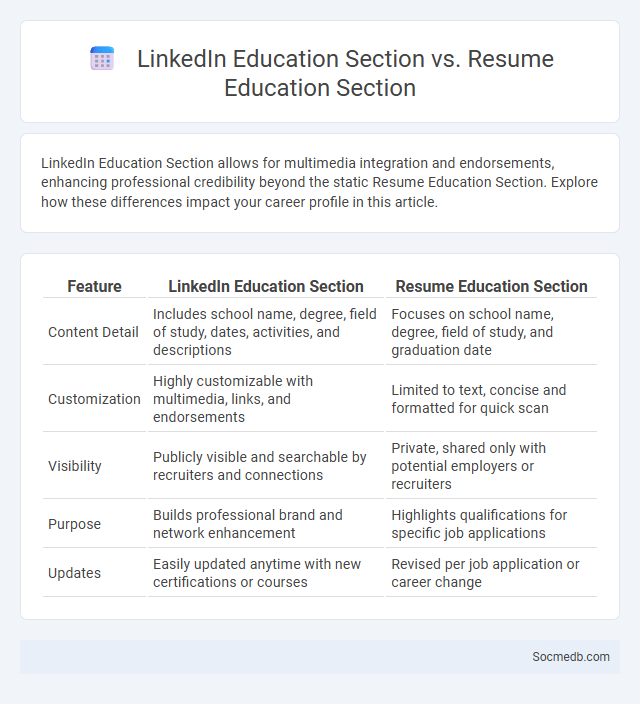
Photo illustration: LinkedIn Education Section vs Resume Education Section
LinkedIn Education Section allows for multimedia integration and endorsements, enhancing professional credibility beyond the static Resume Education Section. Explore how these differences impact your career profile in this article.
Table of Comparison
| Feature | LinkedIn Education Section | Resume Education Section |
|---|---|---|
| Content Detail | Includes school name, degree, field of study, dates, activities, and descriptions | Focuses on school name, degree, field of study, and graduation date |
| Customization | Highly customizable with multimedia, links, and endorsements | Limited to text, concise and formatted for quick scan |
| Visibility | Publicly visible and searchable by recruiters and connections | Private, shared only with potential employers or recruiters |
| Purpose | Builds professional brand and network enhancement | Highlights qualifications for specific job applications |
| Updates | Easily updated anytime with new certifications or courses | Revised per job application or career change |
Understanding the Purpose of LinkedIn vs Resume Education Sections
LinkedIn's education section allows you to showcase your academic background with detailed descriptions, endorsements, and connections, enhancing your professional brand and networking opportunities. Your resume education section should be concise, highlighting key degrees, certifications, and relevant coursework tailored to the job you're applying for. Understanding these differences ensures your LinkedIn profile supports continual professional growth while your resume targets specific job qualifications.
Key Differences Between LinkedIn and Resume Education Details
LinkedIn education details provide a dynamic platform to showcase not only academic achievements but also extracurricular activities, certifications, and endorsements, creating a more comprehensive professional profile. Your resume education section tends to be concise, highlighting only key degrees, institutions, and graduation dates to match specific job requirements. LinkedIn allows for continuous updates and the inclusion of multimedia, which makes it more interactive compared to the static nature of resume education details.
How Recruiters View LinkedIn Education vs Resume
Recruiters often prioritize LinkedIn education details because they provide real-time updates, endorsements, and a broader professional context compared to traditional resumes. Your LinkedIn profile allows recruiters to see verified connections, recommendations, and multimedia that showcase your skills and academic achievements more dynamically. This digital presence frequently leads to a more comprehensive understanding of your qualifications than the static resume format.
Best Practices for LinkedIn Education Entries
Optimize LinkedIn education entries by clearly listing your institution, degree, and graduation dates to enhance credibility and search visibility. Include relevant coursework, certifications, and achievements that align with your career goals to attract recruiters and industry connections. Craft a concise description that highlights your skills and experiences, helping You stand out in a competitive professional network.
Optimizing Education Section for Resume ATS
Optimizing the education section of your resume for ATS involves including specific degree titles, institutions, and graduation dates with relevant keywords tied to social media skills, such as "Digital Marketing," "Social Media Strategy," and "Content Creation." Use standardized formatting and avoid graphics or unusual fonts to ensure ATS accuracy. Tailoring this section to highlight certifications like Facebook Blueprint or Google Analytics can increase your resume's visibility in automated screenings.
Common Mistakes in Education Sections on LinkedIn and Resumes
Common mistakes in education sections on LinkedIn and resumes include listing incomplete or irrelevant qualifications, using inconsistent formatting, and failing to highlight key achievements or certifications. You should ensure your education details are clear, concise, and tailored to your career goals to maximize employer interest. Properly showcasing your academic background can significantly enhance your professional credibility and attract recruiters.
Should You Include Non-Degree Courses and Certifications?
Including non-degree courses and certifications on your social media profiles can significantly enhance your professional credibility and showcase your commitment to continuous learning. Highlighting relevant certifications in fields like digital marketing, coding, or project management attracts potential employers and networking opportunities by demonstrating up-to-date skills. Ensure that each credential aligns with your career goals and adds tangible value to your personal brand.
Formatting Tips for Resume vs LinkedIn Education Sections
Formatting your resume education section concisely highlights your degree, institution, and graduation date using bullet points for easy scanning, while the LinkedIn education section allows for more detailed descriptions of coursework, projects, and honors. Your resume benefits from a clean, uniform font and reverse chronological order to ensure quick recruiter assessment, whereas LinkedIn supports multimedia additions and links, enhancing your online profile's interactivity. Tailoring these sections optimizes your professional image by leveraging resume brevity and LinkedIn's richer storytelling capabilities, boosting your visibility on social media platforms.
Tailoring Your Education Section for Specific Job Applications
Tailoring your education section for specific job applications involves highlighting relevant degrees, certifications, and courses that align with the social media role you seek. Emphasize skills such as digital marketing, content creation, or analytics gained through your studies to demonstrate your expertise. By customizing this section, you increase your chances of passing applicant tracking systems and catching recruiters' attention for social media positions.
LinkedIn and Resume Education Optimization: Dos and Don’ts
Optimize your LinkedIn profile by listing your highest degree with relevant keywords and accomplishments to enhance visibility in recruiter searches. Ensure your resume education section is concise, accurate, and tailored to the job description, avoiding unnecessary details such as high school info when you have advanced degrees. Avoid including outdated certifications or non-relevant courses on both platforms to maintain professionalism and focus on key qualifications.
 socmedb.com
socmedb.com